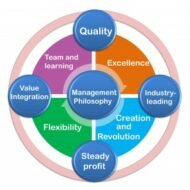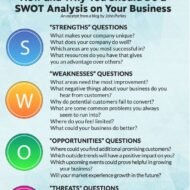Posted by Managementguru in Business Management, Organisational behaviour, Principles of Management
on Mar 6th, 2014 | 0 comments

Corporate Philosophy of Management CORPORATE PHILOSOPHY OF MANAGEMENT calls for creating a framework of values, beliefs and ethical standards which are considered to be vital for an effective management. They must be embedded in formal and informal philosophical statements which are then communicated to the fraternity of that organization. From a broader perspective, the LEADER has to have a VISION as to where he is heading his company in the next three to four years. Corporate Objectives provide vision as well as direction and map for bold decisions to be taken regarding NEW MARKETS MARKET SHARE PRODUCTS SERVICES etc. , Now the organization is in a position to decide and prioritise the VALUES AND COMPETENCIES it expects from its managers. For example, if the situation favors the business expansion to new markets, say, European or Asian, then an organization has to develop competence in areas like LANGUAGE AND CULTURE, besides marketing and business skills. Different Philosophies of Management: Well, you might have been inspired with JAPANESE PHILOSOPHY OF MANAGEMENT, EASTERN OR WESTERN PHILOSOPHY OF MANAGEMENT t. But what is the fun? If you don’t have A SOUND MANAGEMENT PHILOSOPHY of your own, to simply put it, you don’t have a broad set of principles to back up your management development process which is a generic one. Ideally speaking, you should be able to develop a concrete SYSTEM that is made up of FOOL PROOF policies and procedures; try to develop a professional team of executives who can take up your vision to the next level; these measures will prove worthwhile in the long run. You are left without any choice but to develop “truly” INTERNATIONAL MANAGERS who could transcend nationally and the location of any specific job consideration. This is what Ideal management philosophy means to me, A holistic vision of the future A solid set of principles(values, beliefs) Sound policy definition Management development programmes Autonomy to my work force Always “yes “to new technology Development of women managers Flexible leadership Social responsibility Contribution to the growth of my Country’s economy Strategic Perspective: Major environmental shifts now demand a more strategic perspective from those who manage and lead in organizations; “GLOBALISING” in the quest for major market share brings in new opportunities for growth and prosperity. Organizations are now espousing values that regard people, not as costs to be minimized, but AS “ASSETS TO BE MAINTAINED AND DEVELOPED.” An open systems approach of management is likely to overcome many of the problems created by the piecemeal approach. Instead of looking at management development in isolation, see it as an integral part of a wider organizational system that takes care of the processes through which people working for the firm take care of themselves leading to self...

Posted by Managementguru in Business Management, Change management, Marketing, Organisational behaviour, Strategy
on Feb 18th, 2014 | 0 comments

SWOT and Synergy SWOT Analysis On the basis of its resources and behavior, an organization develops certain strengths and weaknesses which when combined lead to synergistic effects. Such effects manifest themselves in the form of organizational competencies. It is necessary for a firm to look for and develop factors that adds to its strength, as strength is considered to be an inherent capacity which an organization can use to gain strategic advantage. Pic Courtesy: Clickfunnels A weakness, on the other hand, is an inherent limitation or constraint which creates a strategic disadvantage for the organization. Financial strength, for example, is a result of availability of financial sources and efficient rotation of funds. A weakness in the operations management area might be a result of inappropriate plant location, obsolete plant layout and technology. It has to be noted that an organization cannot enjoy the privilege of having only strengths and devoid of any weaknesses. Then the performance level would become saturated to the point of monotony and there exists no scope for growth or improvement. Only when presented with challenges, any functional area exhibits synergy, as strengths and weaknesses do not exist in isolation but combine within a functional area, and also across different functional areas. Synergy Synergy is needed at all levels for better productivity. Say, within a functional area like marketing, synergistic effort may occur when the product, pricing, distribution and promotional aspect support each other, resulting in higher level of marketing synergy. The same when happens at an even higher level, leads to operating synergy, say, for example, synergistic efforts between marketing and production department to decide on the production forecast and pricing. Distinctive competence helps a firm to develop strategic advantage that leads to comprehensive growth and development. Limitations of SWOT: A SWOT analysis can over emphasize internal strengths and overlook external threats It can be static and may ignore the changing circumstances It might give undue importance to a single strength or an element of strategy A strength is not necessarily a source of strategic advantage. Amazon.in...




